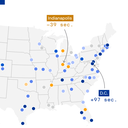Cities with the slowest traffic, mapped

Car commutes have largely gotten slower across America since the mid-pandemic era, per new data from mapping and location tech giant TomTom.
Why it matters: The findings are a reflection of increased traffic as more people head back to the office at least some of the time.
Zoom in: Traffic slowed most significantly in Washington, D.C., New York City and Boston between 2021-2023, based on the average time spent traveling 6 miles in their respective city centers — no shock to anybody who's ever driven in any of the three.
- In D.C., a 6-mile trip took 97 seconds longer last year compared to 2021; in New York it took 87 seconds longer; and in Boston it took 86 seconds longer.
- Traffic actually improved in a handful of cities, including Indianapolis (-39 seconds for that 6-mile trip); Grand Rapids, Michigan (-29 seconds); and Orlando, Florida (-20 seconds).
- See TomTom's full 2023 traffic index here.
The big picture: While some workers are still enjoying at least a hybrid work schedule, the heyday of the work-from-home era is no doubt behind us.
- WFH rates are slowly slipping downward, with just a minority of workers able to enjoy total flexibility these days.
- The result: More car traffic, as the rush-hour rat race resumes.
What they're saying: "People have now gotten into the habit of going back to the office again," Andy Marchant, TomTom's head of global product marketing, tells Axios.
- "What we saw during COVID was 100% working at home, and then what we saw after that was a hybrid model where perhaps they went in one day a week, two days a week, but predominantly still worked at home."
- "And I think what we've seen in the last year by looking at the stats, especially around congestion at rush hour, is that people have gone back to the office more regularly now."
Between the lines: The pandemic was an opportunity for cities to rethink their transportation infrastructure in ways that might push people toward public transit.
- But ridership plummeted during the outbreak, leaving some agencies without the resources or justification for ambitious projects.
Plus: Commutes may now be slower in some cities because of big post-pandemic construction projects, Marchant says, as people find their usual routes blocked.
- That's especially true of European cities, he says — but it's the case in many American metros too, especially as work begins on new projects funded by the 2021 infrastructure law.
Yes, but: At least one grand experiment to get people out of their cars and onto trains and buses is set to begin soon: Manhattan's congestion pricing plan.
- Modeled on London's largely successful effort, the idea is to charge people for driving into the busiest parts of the island — thus encouraging public transit use.
- Yet there's been considerable pushback from commuters, especially across the Hudson River in New Jersey, where transit fees are set to increase this spring.
The bottom line: Three things are certain in life: Death, taxes and rush-hour traffic.